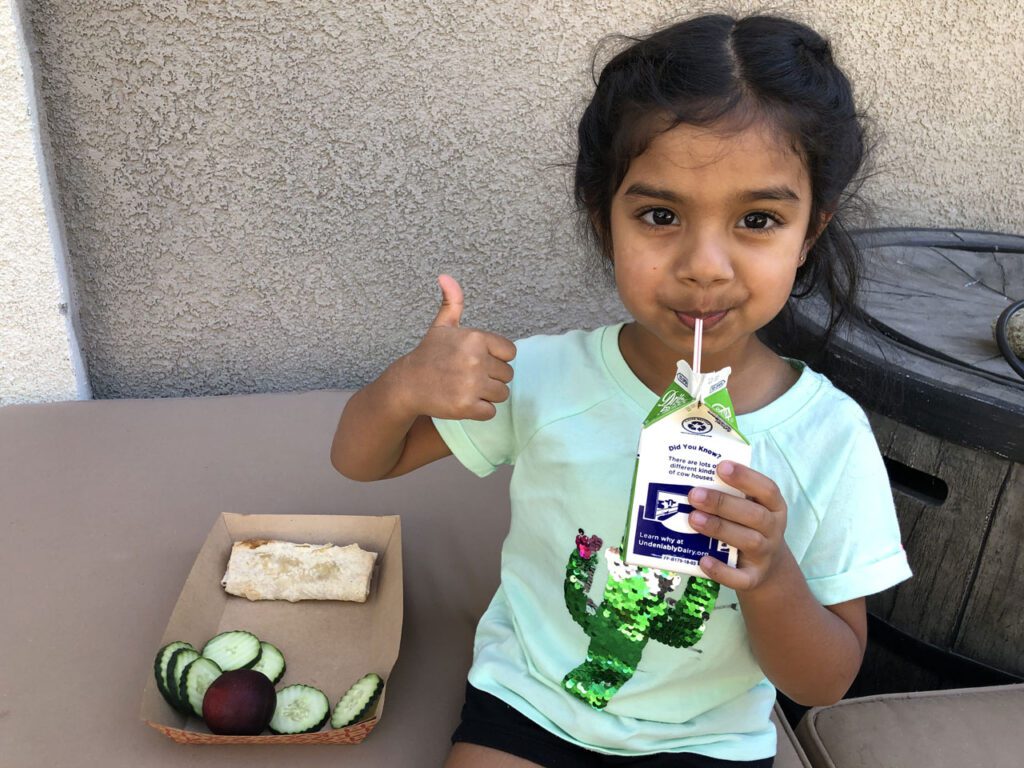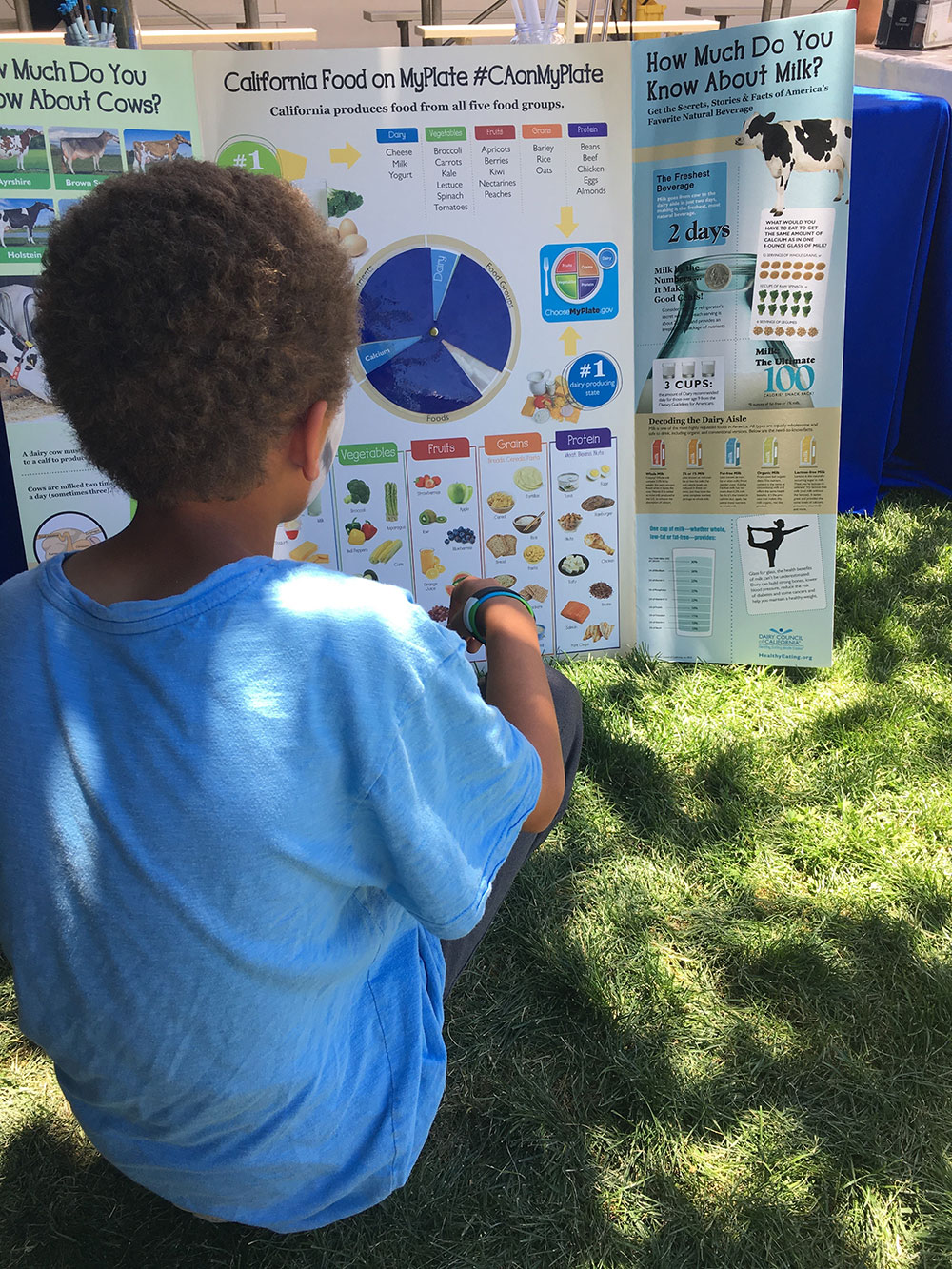Share this page
Activating the Let’s Eat Healthy initiative in schools and beyond
Milk and dairy’s important role in sustainable, healthy eating patterns for children and families


Alignment with SDGs
AUTHOR
Ashley Rosales, Kristal Shelden, Megan Holdaway, Shannan Young, Tracy Mendez Dairy Council of California, Sacramento • USA
Abstract
Achieving the United Nations Sustainable Development Goals requires collaborative, multi-sectoral approaches to build sustainable and resilient food systems. With rising rates of food insecurity and malnutrition, solutions are needed to increase diet quality and provide nutrition security, while meeting sustainability targets. Sustainable nutrition focuses on ensuring wholesome, nutrient-dense foods are accessible, affordable and culturally relevant while also preserving environmental resources and supporting local communities. The public health crisis brought on by the COVID-19 pandemic intensified disparities for underserved populations, presenting challenges and opportunities to supporting nutrition security, particularly for children, as childhood nutrition affects the ability to succeed in school and life and can determine future health outcomes.
Schools are the heart of communities, providing services and a critical safety net to children and families. Dairy Council of California activated the Let’s Eat Healthy initiative to find collaborative solutions to improve nutrition in the school environment by helping increase access to school meals during the onset of the pandemic, innovating to make nutrition education more accessible during extended school closures, and integrating nutrition education and food access together through partnerships. Navigating challenges in a rapidly changing environment requires people and organizations to work together, across disciplines, to leverage knowledge, experience, resources, expertise and creative thinking. Improving access to nutritious foods, like milk and dairy foods, as well as nutrition education will be most effective when done through collaboration, as organizations can discover and scale innovative solutions to ensure children are supported to grow healthfully and reach their full potential.
Introduction
Dairy Council of California is a nutrition organization that collaborates with other local, state, national and international organizations or agencies to elevate the health of children and families through the pursuit of lifelong healthy eating habits. The organization’s science-based nutrition education resources, Farm to School assemblies, professional development programs and online resources educate millions of children and families in California and throughout the United States, demonstrating the dairy industry’s contribution to community health and sustainable nutrition.
In June 2020, Dairy Council of California launched Let’s Eat Healthy, an initiative that brings together educators, health professionals, change-makers, and community leaders to elevate the health of children and families. Let’s Eat Healthy invites multidisciplinary coordination, collaboration, and co-creation to champion community health by teaching and inspiring healthy eating habits and making healthy, wholesome foods accessible and affordable to all California’s diverse communities.
Materials and methods
The abrupt closure of schools at the onset of the COVID-19 pandemic disrupted meal service for millions of children. To support families and school communities, Dairy Council of California partnered with the California Milk Processor Board to develop a landing page for information on meal sites and a state-wide public awareness campaign. The site provided information on school meal sites across the state and eventually expanded to include food bank locations and distance learning nutrition resources.
Through partnerships with educators, Dairy Council of California adapted its Let’s Eat Healthy K–12 curriculum and resources to ensure that children and families were supported with nutrition education during the pandemic. Adaptations included a variety of co-created online resources that easily embed into online learning platforms featuring digital documents, short and informative videos, and grade-appropriate quizzes and games. A new Technology Tutorial Guide walked educators through the process of downloading and embedding resources into online learning platforms and apps for quick and easy implementation.
The shift to remote learning also applied to Dairy Council of California’s Farm to School program, Mobile Dairy Classroom (MDC). MDC is an assembly that brings the farm experience which includes a live dairy cow to students, teaching them how milk and dairy foods get from the farm to the table and how they contribute to a healthy eating pattern. During the 2020–2021 school year, MDC collaborated to begin innovative virtual field trips, combining the traditional experience of an assembly with a virtual farm tour.


Access nutritious and culturally appropriate foods is a core component of sustainable nutrition and vital to achieving nutrition security.
Riana Reinecke Tweet
Results
The campaign and landing page for information on meal sites became a valued resource for California school districts and communities, supporting 528,797 website visits, including 467,823 unique views. Approximately 40% of viewers sought information in Spanish. This effort to ensure students with the greatest need received healthy meals that include milk and dairy was effective because of the collaborative, innovative efforts of individuals and organizations. Perhaps in part due to efforts such as this, participation in the National School Lunch Program in 2020 declined less in the state of California than the national average.
Shifting to remote education models enabled teachers to continue instructing children and families on healthy eating patterns that include nutritious, high-quality foods. The collaborative effort with educators to adapt resources for online learning and continue teaching nutrition despite the challenge of not meeting in person enabled 4.4 million California students and families to engage with Let’s Eat Healthy nutrition resources during the 2020–2021 school year. Over 225,000 students, families, and classrooms engaged with dairy farmers and agriculture instructors through a livestream viewing from the farm.
528,797
website visits
467,823
unique views
225,000
livestream viewings from the farm
Discussion
Making sure people are supported and able to access nutritious and culturally appropriate foods is a core component of sustainable nutrition and vital to achieving nutrition security. Schools support children’s overall health and well-being by providing nourishing meals, especially for those living in socioeconomically disadvantaged communities or food-insecure homes. Student participation in school meal programs is associated with higher intake of dairy foods, fruits, vegetables, and whole grains. These food groups support the intake of important nutrients that are typically under consumed, making school meals an important source of nutrition for many children.
Teaching nutrition education is also part of the solution to address sustainable nutrition. Teachers can make an important contribution to the knowledge and dietary habits of children and these learned skills and positive health behaviors support physical, social, and emotional health, as well as academic success. Moving forward, it is vital that virtual resources remain accessible to children in both traditional and non-traditional learning environments, as well as those outside of the school environment.
Beyond the pandemic, virtual field trips will continue to be an important tool to increase access to educational opportunities for students who may not otherwise be able to participate. Teaching sustainable nutrition through Farm to School programs helps bridge the knowledge gap between agriculture and the food students eat, resulting in a greater awareness of the role agriculture plays in a healthy diet, while a virtual format makes experiential learning accessible to more students, families, and communities around the world.


Conclusion
The Let’s Eat Healthy initiative is one vehicle for bringing people together to find creative solutions to address adaptive challenges such as those presented during the COVID-19 pandemic. Through efforts to improve access to school meals during the onset of the pandemic, innovation to make nutrition education more accessible during extended school closures, and the integration of nutrition education and food access through creative partnerships, Dairy Council of California activated the Let’s Eat Healthy initiative to find solutions to improve nutrition and access to milk and dairy foods in the school environment.
Successful multidisciplinary collaboration that focuses on overcoming adaptive challenges with aligned strategies creates opportunities to positively impact the educational, health and wellness outcomes for children and families, supporting their nutritional needs within the school environment and beyond. To navigate the challenges in a rapidly changing environment, people and organizations must work together, across disciplines, to leverage knowledge, experience, resources, expertise and creative thinking. Improving access to healthy food and nutrition education will be most effective when done through collaboration, as organizations can discover and scale innovative solutions to ensure children are supported and have access to the nutritious foods they need.
References
- United States Department of Agriculture; Food and Nutrition Service. Child Nutrition Tables. Available online: https://www.fns.usda.gov/pd/child-nutrition-tables (accessed 9 March 2022).
- Au L.E. ; Gurzo K ; Gosliner W ; Webb K.L. ; Crawford P.B.; Ritchie L.D. Eating School Meals Is Associated with Healthier Dietary Intakes: The Healthy Communities Study. J. Acad. Nutr. Diet. 118:1474-1481 (2018).
- Cotton W; Dudley D; Peralta L; Werkhoven T. The Effect of Teacher-Delivered Nutrition Education Programs on Elementary-Aged Students: An Updated Systemic Review and Meta-Analysis. Prev. Med. 20:101178 (2020).
- Centers for Disease Control and Prevention; CDC Health Schools. School Nutrition and the Social and Emotional Climate and Learning. Available online: https://www.cdc.gov/healthyschools/nutrition/school_nutrition_sec.htm (accessed on 9 March 2022).






